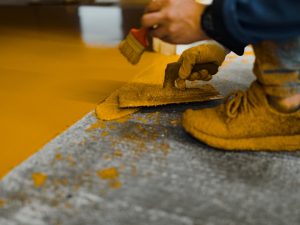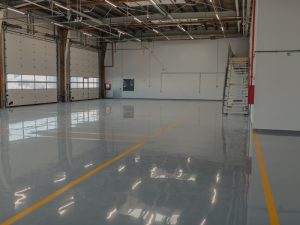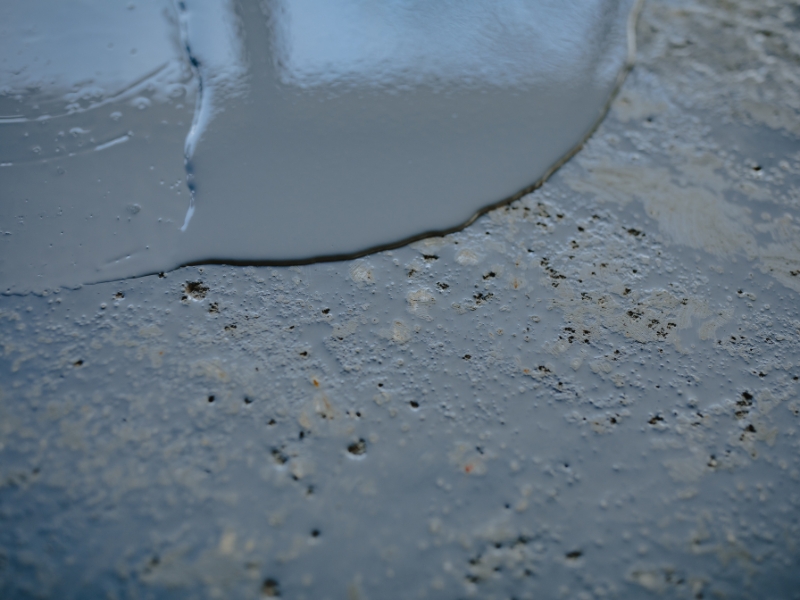Epoxy flooring is famous for its durability and aesthetic appeal in Sydney’s residential and commercial spaces. However, like any surface, it can develop chips over time. A chipped epoxy floor can detract from its overall appearance and performance due to heavy foot traffic, dropped objects, or environmental factors. Luckily, you can quickly fix these issues. This guide will walk you through identifying the cause of the chip, preparing for repairs, and ensuring a long-lasting solution.
How can you identify the cause of the chip in your epoxy floor?
Before starting any repairs, it’s essential to understand why the chip occurred. Identifying the cause can help you prevent future damage. Here are some common reasons for chips in epoxy flooring:
- Heavy Objects: Dropping heavy items can create chips, especially in areas with high foot traffic.
- Improper Installation: If the epoxy is not applied correctly, it might be more susceptible to chipping.
- Moisture: Water or humidity can weaken the adhesive bond, leading to chips.
- Chemical Damage: Harsh chemicals can break down the epoxy’s surface, resulting in chips or peeling.
- Wear and Tear: Constant use can wear down the flooring over time, making it more vulnerable to chipping.
Understanding the cause helps you address underlying issues while performing repairs.
What materials and tools do you need to fix a chipped epoxy floor?
Gathering the suitable materials and tools will make the repair process smoother and more effective. Here’s what you’ll need:
- Epoxy Repair Kit: Available at hardware stores, these kits often include everything required for a repair.
- Putty Knife: This is used to apply the epoxy filler smoothly.
- Sandpaper: Fine-grit sandpaper will help smooth the repaired area.
- Acetone or Isopropyl Alcohol: This cleans the area before repair.
- Protective Gear: Gloves and safety goggles to protect yourself during the process.
- Paint Stir Stick: Useful for mixing the epoxy if it comes in two parts.
Having these materials ready will streamline your repair process.
How do you prepare the area before repairing the chip?
Proper preparation is vital for a successful repair. Follow these steps to prepare the area effectively:

- Clean the Area: Use a cleaner suitable for epoxy floors to remove dust, dirt, and grease from the chipped area.
- Dry the Surface: Ensure the area is completely dry before applying any repair materials. Moisture can interfere with adhesion.
- Inspect for Damage: Check the surrounding area for any additional chips or damage that may need attention.
- Sand the Edges: Lightly sand the edges of the chip to create a rough surface for better adhesion of the epoxy filler.
- Remove Debris: Vacuum or wipe away sanding dust or debris to ensure a clean repair surface.
By taking these steps, you set the stage for a successful and long-lasting repair.
What is the process for repairing a chipped epoxy floor?
Once you’ve prepared the area, you can begin the repair process. Here’s a step-by-step guide:
- Mix the Epoxy: If using a two-part epoxy, follow the instructions to mix it thoroughly. Ensure you achieve a uniform consistency.
- Apply the Epoxy Filler: Using a putty knife, apply the mixed epoxy to the chip, ensuring it is filled. Smooth the surface to match the surrounding floor.
- Let It Cure: The epoxy should be cured according to the manufacturer’s instructions. Curing time can vary depending on temperature and humidity.
- Sand the Repaired Area: Lightly sand the repaired area to create a smooth finish once cured. Be careful not to sand too much, as you want it to blend with the rest of the floor.
- Clean Up: Remove any dust or debris left from sanding.
This process will ensure a seamless repair that restores your epoxy floor’s appearance.
How can you ensure a durable repair for your epoxy floor?
To ensure the longevity of your repair, consider these tips:
- Choose High-Quality Materials: Using a quality epoxy filler will contribute to a more substantial repair. Polyurethane flooring offers a durable and versatile alternative to traditional flooring options, making it an excellent choice for residential and commercial spaces.
- Follow Manufacturer’s Instructions: Adhere strictly to the guidelines provided with your repair kit for the best results.
- Maintain Proper Conditions: Ensure the temperature and humidity are suitable for epoxy application.
- Seal the Floor: Consider applying a sealant to protect the surface and enhance durability after repairs.
- Regular Maintenance: Schedule periodic cleaning and maintenance to keep your epoxy flooring in good condition.
Implementing these strategies will help maintain the integrity of your epoxy floor.
When should you consider replacing your epoxy floor?
While repairing chips is often straightforward, replacement may be the better option. Consider replacing your epoxy floor if:
- Extensive Damage: If the epoxy floor is chipped or damaged beyond repair, replacement might be more cost-effective.
- Significant Wear: If the surface shows signs of extensive wear or discolouration, it may be time for a new installation.
- Water Damage: Replacement is often necessary if moisture has penetrated and caused bubbling or peeling.
- Outdated Aesthetic: If you’re looking to update the look of your space, replacing your epoxy floor can provide a fresh, modern appearance.
Assessing these factors can help you decide whether to repair or replace your epoxy flooring.
What are the benefits of choosing durable epoxy flooring for commercial spaces?
Choosing durable epoxy flooring for commercial spaces offers numerous advantages:

- Durability: Epoxy floors are highly wear-resistant and ideal for high-traffic areas such as warehouses and workshops.
- Easy Maintenance: Cleaning epoxy floors is a breeze, as they resist stains and spills.
- Aesthetic Appeal: Available in various colours and finishes, epoxy can enhance the appearance of your commercial space.
- Cost-Effective: With a long lifespan, epoxy flooring can be a more economical option over time.
- Safety: Epoxy can be treated to provide slip resistance, improving safety in commercial environments.
These benefits make epoxy flooring a smart choice for Sydney businesses investing in durable and functional flooring solutions.
Ready to transform your space?
If your epoxy floor needs a professional touch or if you’re considering a new installation, Sydney Wide Epoxy Flooring is here to help. We specialise in high-quality epoxy flooring solutions tailored to your needs, whether for warehouses, workshops, or commercial kitchens. Our experienced team ensures durable, aesthetic results that enhance your space.
Contact Sydney Wide Epoxy Flooring today to learn more about our services and how we can help you achieve the perfect epoxy flooring for your property!

